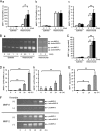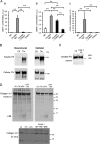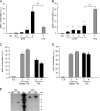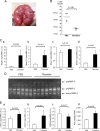Effect of thrombin on human amnion mesenchymal cells, mouse fetal membranes, and preterm birth
- PMID: 24652285
- PMCID: PMC4036339
- DOI: 10.1074/jbc.M114.550541
Effect of thrombin on human amnion mesenchymal cells, mouse fetal membranes, and preterm birth
Abstract
Here, we investigated the effects of thrombin on matrix metalloproteinases (MMPs) and prostaglandin (PG) synthesis in fetal membranes. Thrombin activity was increased in human amnion from preterm deliveries. Treatment of mesenchymal, but not epithelial, cells with thrombin resulted in increased MMP-1 and MMP-9 mRNA and enzymatic activity. Thrombin also increased COX2 mRNA and PGE2 in these cells. Protease-activated receptor-1 (PAR-1) was localized to amnion mesenchymal and decidual cells. PAR-1-specific inhibitors and activating peptides indicated that thrombin-induced up-regulation of MMP-9 was mediated via PAR-1. In contrast, thrombin-induced up-regulation of MMP-1 and COX-2 was mediated through Toll-like receptor-4, possibly through thrombin-induced release of soluble fetal fibronectin. In vivo, thrombin-injected pregnant mice delivered preterm. Mmp8, Mmp9, and Mmp13, and PGE2 content was increased significantly in fetal membranes from thrombin-injected animals. These results indicate that thrombin acts through multiple mechanisms to activate MMPs and PGE2 synthesis in amnion.
Keywords: Amnion; Cyclooxygenase (COX) Pathway; Decidua; Fetal Membrane; Fibronectin; Matrix Metalloproteinase (MMP); Prostaglandins; Protease-activated Receptor-1; Thrombin.
Figures










Similar articles
-
Nrf2 Activation Inhibits Effects of Thrombin in Human Amnion Cells and Thrombin-Induced Preterm Birth in Mice.J Clin Endocrinol Metab. 2016 Jun;101(6):2612-21. doi: 10.1210/jc.2016-1059. Epub 2016 Apr 6. J Clin Endocrinol Metab. 2016. PMID: 27050800 Free PMC article.
-
Fetal fibronectin signaling induces matrix metalloproteases and cyclooxygenase-2 (COX-2) in amnion cells and preterm birth in mice.J Biol Chem. 2013 Jan 18;288(3):1953-66. doi: 10.1074/jbc.M112.424366. Epub 2012 Nov 26. J Biol Chem. 2013. PMID: 23184961 Free PMC article.
-
Activation of prostaglandin EP4 receptor attenuates the induction of cyclooxygenase-2 expression by EP2 receptor activation in human amnion fibroblasts: implications for parturition.FASEB J. 2019 Jul;33(7):8148-8160. doi: 10.1096/fj.201802642R. Epub 2019 Mar 27. FASEB J. 2019. PMID: 30917001
-
Apelin is decreased with human preterm and term labor and regulates prolabor mediators in human primary amnion cells.Reprod Sci. 2013 Aug;20(8):957-67. doi: 10.1177/1933719112472741. Epub 2013 Jan 11. Reprod Sci. 2013. PMID: 23314958 Free PMC article.
-
Infection-induced thrombin production: a potential novel mechanism for preterm premature rupture of membranes (PPROM).Am J Obstet Gynecol. 2018 Jul;219(1):101.e1-101.e12. doi: 10.1016/j.ajog.2018.04.014. Epub 2018 Apr 13. Am J Obstet Gynecol. 2018. PMID: 29660299 Free PMC article.
Cited by
-
Mechanisms of thrombin-Induced myometrial contractions: Potential targets of progesterone.PLoS One. 2020 May 4;15(5):e0231944. doi: 10.1371/journal.pone.0231944. eCollection 2020. PLoS One. 2020. PMID: 32365105 Free PMC article.
-
The role of decidual cells in uterine hemostasis, menstruation, inflammation, adverse pregnancy outcomes and abnormal uterine bleeding.Hum Reprod Update. 2016 Jun;22(4):497-515. doi: 10.1093/humupd/dmw004. Epub 2016 Feb 23. Hum Reprod Update. 2016. PMID: 26912000 Free PMC article. Review.
-
Nrf2 Activation Inhibits Effects of Thrombin in Human Amnion Cells and Thrombin-Induced Preterm Birth in Mice.J Clin Endocrinol Metab. 2016 Jun;101(6):2612-21. doi: 10.1210/jc.2016-1059. Epub 2016 Apr 6. J Clin Endocrinol Metab. 2016. PMID: 27050800 Free PMC article.
-
Baicalin protects against thrombin induced cell injury in SH-SY5Y cells.Int J Clin Exp Pathol. 2015 Nov 1;8(11):14021-7. eCollection 2015. Int J Clin Exp Pathol. 2015. PMID: 26823714 Free PMC article.
-
Thrombin Augments LPS-Induced Human Endometrial Endothelial Cell Inflammation via PAR1 Activation.Am J Reprod Immunol. 2016 Jul;76(1):29-37. doi: 10.1111/aji.12517. Epub 2016 Apr 24. Am J Reprod Immunol. 2016. PMID: 27108773 Free PMC article.
References
-
- Chaiworapongsa T., Espinoza J., Yoshimatsu J., Kim Y. M., Bujold E., Edwin S., Yoon B. H., Romero R. (2002) Activation of coagulation system in preterm labor and preterm premature rupture of membranes. J. Matern. Fetal Neonatal Med. 11, 368–373 - PubMed
-
- Erez O., Romer R., Vaisbuch E., Chaiworapongsa T., Kusanovic J. P., Mazaki-Tovi S., Gotsch F., Gomez R., Maymon E., Pacora P., Edwin S. S., Kim C. J., Than N. G., Mittal P., Yeo L., Dong Z., Yoon B. H., Hassan S. S., Mazor M. (2009) Changes in amniotic fluid concentration of thrombin-antithrombin III complexes in patients with preterm labor: evidence of an increased thrombin generation. J. Matern. Fetal Neonatal Med. 22, 971–982 - PMC - PubMed
-
- Rosen T., Kuczynski E., O'Neill L. M., Funai E. F., Lockwood C. J. (2001) Plasma levels of thrombin-antithrombin complexes predict preterm premature rupture of the fetal membranes. J. Matern Fetal Med. 10, 297–300 - PubMed
-
- Nagy S., Bush M., Stone J., Lapinski R. H., Gardó S. (2003) Clinical significance of subchorionic and retroplacental hematomas detected in the first trimester of pregnancy. Obstet. Gynecol. 102, 94–100 - PubMed
Publication types
MeSH terms
Substances
Grants and funding
LinkOut - more resources
Full Text Sources
Other Literature Sources
Research Materials
Miscellaneous

